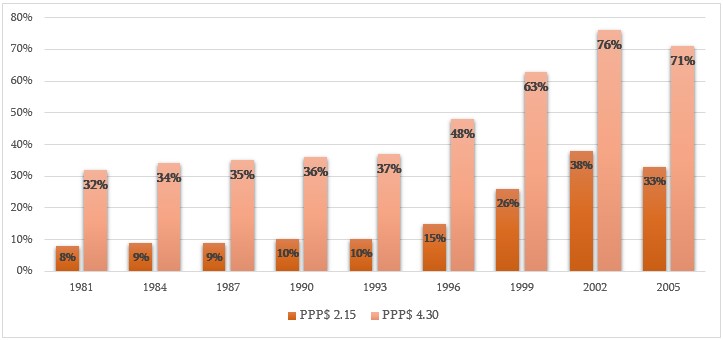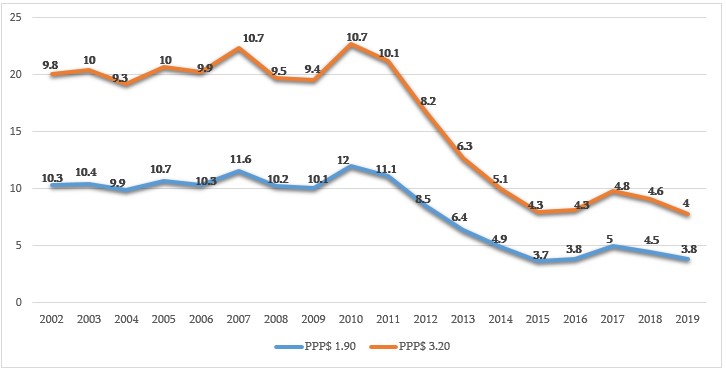Levan Vasadze: “Prior to gaining independence, less than 1% of the Georgian population lived under the poverty line.”
Verdict: FactCheck concludes that Levan Vasadze’s statement is MOSTLY FALSE.
Resume: Poverty is one of Georgia’s biggest challenges. In accordance with 2019’s data, 19.5% of the country’s population lives in absolute poverty. However, poverty has been a challenge not only for the last 30-year period. The claim that less than 1% of the Georgian people lived in poverty prior to gaining independence is false.
Analysis
On 6 May 2021, on air on Ghamis Kurieri, businessman and the leader of the recently founded Unity, Essence, Hope movement, Levan Vasadze, spoke about the 30-year period of Georgia’s gaining independence to the present day. According to Mr Vasadze, less than 1% in Georgia used to live in poverty whilst this figure currently stands at 20%.
Since gaining independence, poverty has been one of Georgia’s biggest challenges. Of note is that the Soviet system plunged into a deep economic crisis in 1990 and so it is hard to imagine that poverty and inequality in the USSR were previously at very low levels.
According to the United Nations Development Programme 2009 report, poverty figures in the former USSR countries, including Georgia, were higher in the post-Soviet period as compared to Soviet times. In 1980-1990, 8-10% of the Georgian population lived in absolute poverty, meaning that their daily consumption was below 2.15 PPP dollars (considering purchasing power). The portion of the population whose daily consumption was below 4.30 PPP dollars fluctuated from 32% to 36%. In 2002, the extreme poverty figure reached 38% whilst general poverty rose to 76%.
Poverty in Georgia increased sharply in the 1990s which was directly stipulated by the war, losing territories and the deep economic crisis.
Graph 1: Poverty Levels in 1981-2005

Source: UNDP – Poverty, Inequality and Social Policy Reform in the Former Soviet Union; World Bank database
According to the National Statistics Office of Georgia, 19.5% of the Georgian population lived under the absolute poverty line. The methodology for the calculation of absolute poverty is based on the World Bank’s Basic Needs Approach and the subsistence minimum is used as the poverty line. In 2004-2010, the poverty figure was nearly 34%-38%. A poverty reduction trend started in 2011 and it continuously decreased up until 2016. In 2016, the share of the population under the poverty line increased slightly whilst the poverty indicator remained almost the same in 2017. The poverty figures decreased again in 2018 and 2019 (see Graph 2).
The COVID-19 pandemic and the stringent restrictions inflicted a heavy blow to the Georgian economy in 2020. Job and income losses amid the pandemic proved to be the most serious problem, leading to an impoverishment of the population. According to the World Bank’s data, national poverty in Georgia increased by 5.4 percentage points in 2020.
Graph 2: Share of the Population Under the Absolute Poverty Line (%)

Source: National Statistics Office of Georgia
The World Bank measures the poverty level by consumption expenditures. In particular, 1.90 PPP USD and 3.20 PPP USD per day serve as the poverty threshold. According to 2019’s data, the daily consumption of 3.8% of the Georgian population is under 1.90 PPP dollars which is 2.7 times less as compared to the 2002-2003 figure. In 2019, 4% of the population consumed less than 3.20 PPP dollars daily and this figure dropped nearly 2.5 times as compared to 2002-2003. In the course of 2002-2019, the highest figures of poverty were in 2010 owing to the post-war period and the world financial crisis. A poverty reduction trend has started since 2011.
Graph 3: Poverty Trend in 1997-2019 (1.90 PPP Dollars and 3.20 PPP Dollars Per Day Serve as Poverty Line)

Source: World Bank








